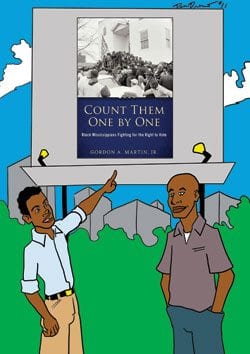
‘Count Them One by One’
Americans involved in the campaign for racial equality were sorely disappointed with the Civil Rights Act of 1957. The provisions they had sought did not become law until the Civil Rights Act of 1964 and the Voting Rights Act of 1965. Until now there has been little acknowledgement of the importance of the 1957 law.
Gordon A. Martin Jr. has rescued the 1957 Act from the dustbin of history. His new book “Count Them One by One: Black Mississippians Fighting for the Right to Vote” casts a new light on the importance of the Act.
A major objective of the Act was to establish the office of Assistant Attorney General for Civil Rights within the Justice Department. Consequently, U.S. Attorney General William P. Rogers established the Civil Rights Division within his office. Martin’s book is an account of how lawyers from this new division won United States v. Lynd and opened the door for the registration of black voters in the South.
Martin’s research indicates that it was appropriate for the Civil Rights Division to begin its efforts in Mississippi. According to the national NAACP office, between 1889 and 1945 there were 476 lynchings in Mississippi. In 1890, 55.5 percent of the voting age population was black, so there was great incentive for whites to restrict the black vote. Martin reports that in 1892 in order to vote an adult male had to be “duly registered,” have paid his taxes including a poll tax, not to be a felon and be able to read or understand “any section of the Mississippi Constitution.”
There are 82 counties in Mississippi and each one elects a circuit clerk who is responsible for registering voters. In Forrest County with the county seat in Hattiesburg, black residents sued the Circuit Clerk Luther Cox in 1950 for refusing to register them. Most of them had baccalaureate degrees and some had masters. Before rejecting applicants, Cox would often ask such foolish questions as “how many bubbles are there in a bar of soap?”
The existence of a courageous and well educated group of black complainants made Forrest County a good target for Justice Department lawyers. The State of Mississippi had also made itself a target when the legislature resolved to defy the law after the Brown v. Board of Education decision on May 17, 1954. By March 29, 1956 the state had established the Mississippi State Sovereignty Commission as a sort of local CIA to undermine any effort to end racial discrimination.
Prior to the involvement of the Civil Rights Division lawyers, efforts for suffrage by blacks in Mississippi had been fruitless. According to the 1960 census, 36.1 percent of the voting age population was non-white but they were only 6.2 percent of the registered voters. Forrest County had 12 black voters but 13 counties had none.
Theron Lynd had replaced Cox as circuit clerk when Martin came to Mississippi as a lawyer to help prepare the litigation for the Civil Rights Division. Martin provides a personal account of his contacts with witnesses, and the conduct of the hearings. But as a scholar and historian he provides extensive information not only on the culture of Mississippi but also on the political process for selecting U.S. District Court judges and members of the Fifth Circuit of the Federal Circuit Court of Appeals.
The Civil Rights Act of 1957 created the Civil Rights Division in the Justice Department. Publicity on their work on the Lynd case in Mississippi revealed an unacceptable aspect of American life. These disclosures made it easier, politically, to pass the Voting Rights Act of 1965. Martin’s work has elevated the Civil Rights Act of 1957 to a higher level of significance.


![Banner [Virtual] Art Gallery](https://baystatebanner.com/wp-content/uploads/2024/04/Cagen-Luse_Men-at-store-e1713991226112-150x150.jpg)



